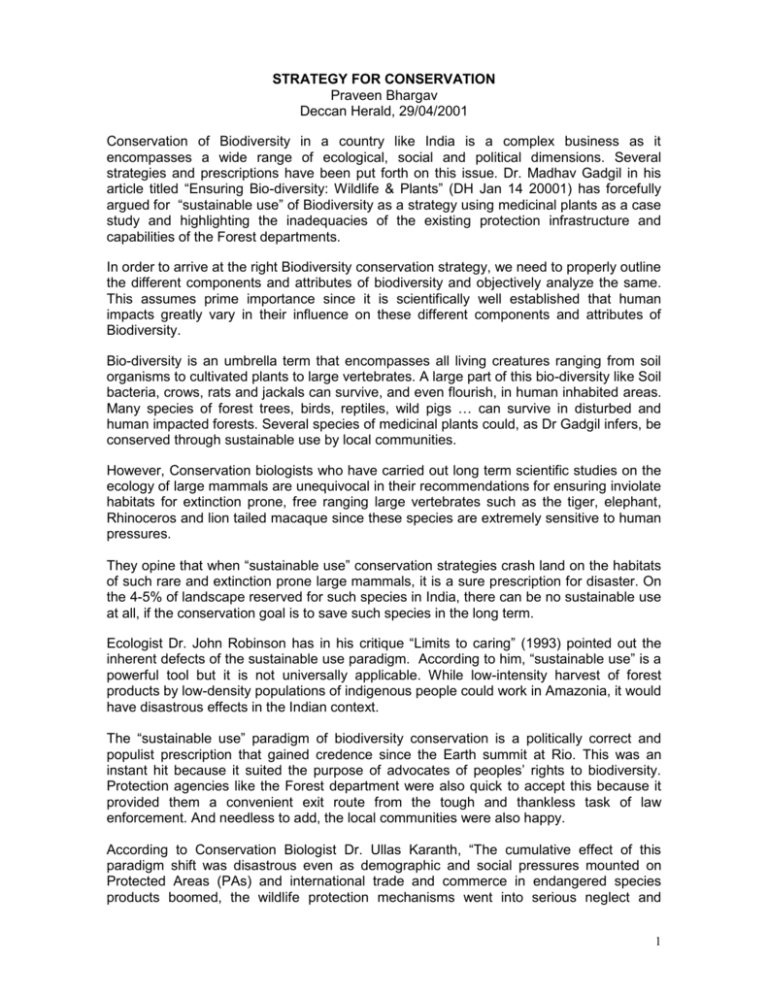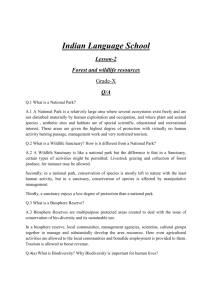DRAFT (1300 words)
advertisement

STRATEGY FOR CONSERVATION Praveen Bhargav Deccan Herald, 29/04/2001 Conservation of Biodiversity in a country like India is a complex business as it encompasses a wide range of ecological, social and political dimensions. Several strategies and prescriptions have been put forth on this issue. Dr. Madhav Gadgil in his article titled “Ensuring Bio-diversity: Wildlife & Plants” (DH Jan 14 20001) has forcefully argued for “sustainable use” of Biodiversity as a strategy using medicinal plants as a case study and highlighting the inadequacies of the existing protection infrastructure and capabilities of the Forest departments. In order to arrive at the right Biodiversity conservation strategy, we need to properly outline the different components and attributes of biodiversity and objectively analyze the same. This assumes prime importance since it is scientifically well established that human impacts greatly vary in their influence on these different components and attributes of Biodiversity. Bio-diversity is an umbrella term that encompasses all living creatures ranging from soil organisms to cultivated plants to large vertebrates. A large part of this bio-diversity like Soil bacteria, crows, rats and jackals can survive, and even flourish, in human inhabited areas. Many species of forest trees, birds, reptiles, wild pigs … can survive in disturbed and human impacted forests. Several species of medicinal plants could, as Dr Gadgil infers, be conserved through sustainable use by local communities. However, Conservation biologists who have carried out long term scientific studies on the ecology of large mammals are unequivocal in their recommendations for ensuring inviolate habitats for extinction prone, free ranging large vertebrates such as the tiger, elephant, Rhinoceros and lion tailed macaque since these species are extremely sensitive to human pressures. They opine that when “sustainable use” conservation strategies crash land on the habitats of such rare and extinction prone large mammals, it is a sure prescription for disaster. On the 4-5% of landscape reserved for such species in India, there can be no sustainable use at all, if the conservation goal is to save such species in the long term. Ecologist Dr. John Robinson has in his critique “Limits to caring” (1993) pointed out the inherent defects of the sustainable use paradigm. According to him, “sustainable use” is a powerful tool but it is not universally applicable. While low-intensity harvest of forest products by low-density populations of indigenous people could work in Amazonia, it would have disastrous effects in the Indian context. The “sustainable use” paradigm of biodiversity conservation is a politically correct and populist prescription that gained credence since the Earth summit at Rio. This was an instant hit because it suited the purpose of advocates of peoples’ rights to biodiversity. Protection agencies like the Forest department were also quick to accept this because it provided them a convenient exit route from the tough and thankless task of law enforcement. And needless to add, the local communities were also happy. According to Conservation Biologist Dr. Ullas Karanth, “The cumulative effect of this paradigm shift was disastrous even as demographic and social pressures mounted on Protected Areas (PAs) and international trade and commerce in endangered species products boomed, the wildlife protection mechanisms went into serious neglect and 1 decline. By the mid-1990s, Indian wildlife parks had lost about 60% of the protective capabilities that existed a decade earlier”. “In cases like India where reasonably intact wildlife communities occur on less than 1% of the land, attempt at ‘sustainable harvest’ to meet the rising needs of a billion strong human population were clearly doomed to fail”. NEGATIVE IMPACTS While Dr. Gadgil is right in pointing out that the protection machinery needs strengthening as the forest departments are under staffed and under equipped, he seems to be completely unaware of the real impacts of poaching, which he simply projects as a poacher equipped with a gun, mobile phone and a jeep. Due to a combination of Forest department decay and the growing voice of peoples’ rights to biodiversity and their “harmonious” coexistence with wildlife, protected areas are being hammered, apart from logging, industry and development, by local people who operate insidiously and wipe out wildlife through ingenious traps, snares, deadfall traps…What is not known to many is the fact that such forms of poaching, which is happening on a large scale, all over the country is invariably facilitated when (barring the odd exception) access to the interiors of our Protected areas is gained under the garb of “sustainable exploitation” of minor forest produce (MFP). The forests of the northeast, managed almost wholly by the tribals, are truly illustrative of the damage being caused by such local hunting on a large scale. Landscapes which show up as “dense forests” with a crown density of 40% plus on satellite imagery are today what Dr. Kent Redford very aptly termed as “empty forests” i.e. forests bereft of wild animals. If one were to further consider the almost total destruction of village/community forests and gomals, which were not governed by ‘imperialist’ forest laws but managed entirely by local communities, we would be in a better position to realize the real impacts and dangers associated with sustainable community exploitation. Further, sustainable use of MFP is touted as a harmonious conservation solution. This may work in areas where human densities are low (< 1 person/100 sqkms) and collection is for the bonafide use of the community. In the Indian context, sustainable MFP collection is, in several ways, similar to mining and causes severe damage to wildlife habitats. The debarking of the machilus tree for making incense sticks or the collection of the root of Rauvolfia serpentina kills the plant/tree itself. Thus, if MFP is commercially, albeit sustainably, harvested for thriving local, urban and international markets by communities whose population densities exceed 10 persons/sq. km, as in the case of our PAs it would have disastrous impacts on large mammal habitats. To quote Dr. Karanth, “In India, the extirpation of the Cheetah and the near extirpation of the wolf, the restricted distribution of breeding populations of tigers and lions to less than 0.5% of their former distributional range, show clearly that their co-existence with humans has cost them dearly”. So, how does one ensure the safety and survival of extinction prone large mammals even while ensuring equitable share of the biodiversity to local communities? Dr. Robinson has propounded an alternate paradigm of “sustainable landscapes”. This slightly more complex strategy entails strictly protected areas for preserving sensitive extinction prone wildlife species and eco-systems; multiple use conservation areas for perpetuating a larger 2 subset of bio-diversity tolerant of some human impacts, and, intensive use of other agricultural and industrial landscapes to primarily meet human needs and aspirations. This in essence, endorses our present conservation strategy of Protection and reduction of human pressures on PAs and the need to have atleast 1-2% of our forests inviolate while trying to ensure economic growth and social justice by effectively using the balance 98% of India’s landscape. However, serious efforts from policy makers, conservationists and experts are required to strengthen this, considering the huge assault on this model mounted by the Social activist groups advocating the “Sustainable Use” approach with ideological zeal. Collection and harvest of MFP, like mining is not sustainable in the long term since it destroys the resource itself. The only model of sustainable use that has withstood the test of time is agriculture. Hence cultivation and not collection is the real answer to conserve biodiversity and ensure socio- economic development of local communities. With the phenomenal increase in the demand for wildlife and forest produce, it is imperative to urgently strengthen the protection infrastructure and capacity of the Wildlife wings of Forest departments across the country. In order to overcome the serious staff shortage, particularly of frontline protection staff, redeployment of surplus staff from other wings of the department and providing employment to young, able bodied tribals/locals by modifying recruitment rules would greatly help. The establishment of a separate Wildlife sub-cadre within the Indian Forest service would be most beneficial to ensure the posting of motivated and interested officers to the wildlife wing. Ultimately, any strategy to arrest or reverse the decline of biodiversity should be free of polemics and ideological posturing and instead strive to build workable conservation models based on hard scientific data. This mandates that ecologists who are involved by the government to evolve the right strategy should desist the temptation to masquerade as activists by propounding populist “sustainable use” prescriptions for all landscapes which may well sound the death knell for several rare and endangered forms of biodiversity. 3









